How Does Santa Do It? — AI Show
December 20, 2018 in AI & Engineering

Scott: Welcome to the AI show. Today we're asking the question. The big question, the really big question, the secret deep down thing that we think we've uncovered: What is Santa's secret.
Susan: Yeah how? How does that big jolly red guy do it?
Scott: How does he do it? We think we figured it out though.
Susan: I mean it's pretty obvious what he's doing.
Scott: Yeah, it's really obvious.
Susan: When you lay out the facts, like he's got a horde of tasks he's gotta do. The orders of magnitudes of tasks that he's gotta do. Like it's not normal to be able to do this kind of thing. Just one man, he has elves, in the North Pole, cold place. And he has all these millions, billions of people to visit around the world.
What assets does he have to do this?
Susan: The first asset that gave us the real clue was he's been collecting a lot of data. For years. So he knows, he knows when you've been naughty, he knows when you've been nice.
Scott: He's making a list, checking it twice. You're sending him letters, to the north pole. You're calling in.
Susan: So what does this mean?
Scott: You're meeting him at the mall.
Susan: What is Santa's secret Scott?
Scott: The way he can do it is he obviously has uncovered the ways of AI way before anybody else.
Susan: Way before everybody else.
Scott: And he hasn't told anybody. Kind of a not so good guy move though, Santa. Why do you think he's at the north pole?
Susan: I don't know maybe because he had a heat problem to solve.
Scott: He has lots of data centers. You know he's got a problem, it needs to be cold. You have to process his data, you have to train your models.
Susan: Just imagine what the energy costs would be if you did it somewhere in California. It would be ridiculous just the heating and cooling.
Scott: Especially hundreds of years ago.
Susan: He needs that nice big cold sink for all those GPUs he's got running and all that. How much data does this guy have?
Scott: It grows over the years too.
Susan: Hundreds of years of detailed information, enough information that you can make a clear determination of naughty or nice in a person.
Scott: This is where we get into it. He's got data centers, he's got data, he's got all this. He's got his feelers out there. You know his mall Santa with his probably IOT device ridden suit that he's wearing, collecting data. But he has all this data from the past hundreds of years. And people saying what they want, what they've been doing. You know whether they've been awake or not. He has to make predictions based on that but, he's got all these letters coming in. How do you think he reads all those letter?
Susan: Well let's just say Santa's secret is machine learning. That's Santa's secret. It's clear.
Scott: That's it. it's obvious.
Susan: It is so obvious.
Scott: He's using OCR, to read letters. That people are sending in to him.
Susan: He's doing real, deep language processing on them too. I mean, so you've got OCR, perfect recognition and now you've got the text. You're not gonna read all that. You gotta have something, you gotta get to something that says, "Oh, this is this person. These are their gift ideas. This is their special circumstances as mentioned in the letter." And you've gotta do some pretty serious processing to rip all that out in a usable way.
Scott: That's just the first step. Yeah come on, you're gathering data about everybody. You're probably serving ads, like he's probably selling data to all the tech companies so they'll help him sell ads. That's how he's funding this operation.
Susan: Yeah Santa could be the original startup. Seriously.
Scott: That's deep. He was the first start up.
Susan: The original.
Scott: I hear he was born in Turkey.
Susan: You know what there's a lot of entrepreneurship there. You know if you go to Istanbul, you will definitely see entrepreneurs at work.

Saint Nicholas of Myra born in the 4th-century in Lycia, now southern Turkey. St. Nick was known for generously giving gifts to the poor.
Scott: So how did he get from Turkey to the North pole? It's just he needed a cold spot to put all the servers.
Susan: Well yeah I mean you know, when you start thinking about this logically. The only way you can do this is lots of servers and lots of servers demand that.
Scott: This is probably why, hey no fault on Santa here. I think there's some fault on him here, you can put some blame on him. He's probably the one melting the polar ice caps.
Susan: Oh man, you think?
Scott: Yeah.
Susan: Oh so Santa could be the origin of global meltdowns going on there.
Scott: People say commercialism is ruining Christmas. I think Christmas is ruining the environment.
Susan: It could be, at the ice and the north pole, the polar ice cap there it's the lowest, thinnest and youngest in 60 years. According to various headlines. I didn't read the rest of the article.
Scott: So there is the man side that he has to do and supply side he has to make these meet. How's he figure out how many different types of toys he needs for everyone?
Susan: Well let's break down Santa's big problem here. First of all he's clearly got a really heavy duty classification algorithm for naughty or nice. I bet you the same technology that goes into naughty or nice also does present prediction.
Scott: So when you know all these qualities about a person, what are you gonna give them.
Susan: You run this on every child in the world and now you can clearly start figuring out demand and what your cost overlays are gonna be for that.
Scott: This is the reason you don't always get what you want for Christmas.
Susan: It’s true.
Scott: Machine learning models aren't perfect. It's averaging over all the past history about what to give you.
Susan: Honestly how many times have you gotten what you asked for, but it wasn't what you wanted.
Scott: He knows something deeper about you than you know about yourself.
Susan: You really did want that pair of boxer shorts for Christmas.
Scott: Yeah he needed it. Six months later he knew.
Susan: Yeah well which would you, you could have that small action figure that you're gonna lose in 20 seconds. Or those boxer shorts that you're gonna have six months later.
Scott: Aggregate it over the year.
Susan: Yeah, you are a lot happier. So Santa at least his deep learning jobs might be better than we think. I mean he's been doing it for a long time obviously.
Scott: Yeah, we need to talk to him.
Susan: What are Santa's assets? A tremendous data store.
Scott: I don't know where he got the computing power though.
Susan: Well, some things are gonna be a mystery.
Scott: Christmas spirit?
Susan: Possibly.
Scott: Belief?
Susan: Maybe that's what it is.
Scott: Oh this might be it. It's belief in Santa before is what powered it. But now it's sort of waning and now he has to supplement it with reindeer dung, and this heats up his centers.
Susan: It sounds like a plot to a bad hallmark movie.
Scott: May or may not have seen it already.
Susan: Santa's got some really great things going for him although I would say.
Scott: Big problems though.
Susan: There's a lot of issues that Santa's has to overcome. Think of all that data and all these different countries.
Is Santa GDPR compliant?
Scott: Oh that's a big question.
Susan: I mean he's got really detailed personal information.
Scott: He needed to get his stuff in order this year. This is the first GDPR'd Christmas.
Scott: Stuff might be coming late.
Susan: Maybe he had to use less information.
Scott: Maybe the predictions aren't as good now.
Susan: Because he had to clean out his data stores, they'll lose those terabytes of data on people. Sorry UK.
Scott: He's moving to Ireland or moving out of Ireland now.
Susan: Maybe he's got some good legal loopholes.
Scott: Yeah well, that's kinda what Ireland's about.
Susan: Right he's moved his data. Yeah in ways that might be questionable but...
Scott: I believe that, yeah. it's not coming through standard means. Well he has a really high powered transport you know. It's like a ultimate smuggling device. It's like you could send terabytes, petabytes of information through the internet. But you could also just load up the sleigh with hard drives and move it over and undetectable.

If Santa's sleigh is about the size of a Cadillac Escalade, then it can hold roughly 6800 15TB hard drives, or roughly 105 petabytes (assuming that he is at least using the very biggest hard drives available in December 2018).
Susan: He's clearly got amazing technology. But his business model, it's an interesting business model. Maybe he's been looking at the long term.
Scott: Is it a long con?
Susan: He knew that data was the new oil. Or was going to be the new oil. So he's been collecting it for a very long time.
Scott: He's gonna be a banker.
Susan: And now it's time to payout. Right, all those gifts. Do you think the elves really made them or maybe their various toy companies saying push this product this year. Like he's seating the right kids to get their friends to go out and buy.
Scott: You bring up an interesting question about the lifecycle of data. He's been collecting for hundreds of years as well. A lot of the people he's collected data on aren't here any more.
What does he do with old data?
Susan: Exactly. How useful is it to know that in 1860 the hula hoop was the hot toy.
Scott: But it still might be.
Susan: You can get trend analysis, you can see how a toy takes off and it falls over time.
Scott: Yeah, but it's now totally fair use for him. That's not covered by GDPR.
Susan: Oh yeah, it's old enough, old enough information right? So that's good.
Scott: Maybe he'll be releasing datasets on Kaggle or something?
Susan: Oh that'd be awesome the naughty, nice prediction contest?
Scott: Yeah maybe we could talk to him and get that going?
Susan: Here are 30 attributes about a child.
Scott: That's a good question. What is the real data he has to make these predictions?
Susan: What's useful to determine naughty or nice? But more to the point, how did he train the classifiers in the first place, how does he calibrate naughty and nice. Is this a reinforcement learning question where over time...
Scott: Is Santa biased? Big deep one there.
Susan: How naughty you are depends on where you were born?
Scott: He knows your names, the names on the list. Glean a few things just from that. But he's had the IOT device ridden mall Santa, his robots, his minions are out there.

Susan: Probably, he doesn't own the various Santa's out there. That'd be just, I mean. Conspiracies of more than one person, just fall apart. Right? But maybe he's got the clothing line down.
Scott: He's got the elves to make them, he's got everything right? He has to have an amazing manufacturing facility out there too. Using deep learning machine vision, etc., it's really pumped that good stuff out.
Susan: A lotta robotic stuff. Like, are elves really people, or are they alive, or are they something else?
Scott: Yeah that's a good point. Maybe you replaced the elves a long time ago.
Susan: I mean come on, you gotta a lot of robots going around up there.
Scott: Yeah maybe he's responsible on the uplift of the Japanese robotics market. He's been buying.
Susan: Could be, machine learning and robotics are like a match made in heaven, right there you know. A lotta work in that world.
Scott: Well he's obviously an expert so.
Susan: When I really think about what Santa must have accomplished, I'm quite frankly in awe. The orders of scale, the precision of what he's doing. The resources that he gathers and employs. Santa is, from all practical purposes, he's like the biggest purveyor of machine learning on the planet.
Scott: Yeah he has to be. He touches everybody.
Susan: Everybody. It's just absolutely insane.
Scott: Everybody knows about him at least, right? At least half the people.
Why hasn't anyone else come to these same conclusions?
Scott: I guess that's one of those things. It's a zeitgeist right? It's just a time for it to come out? Well obviously we didn't know about machine learning before or the extent to which it could be spread throughout the world on all these different tasks. You look back and you're like "Duh".
Susan: That's it, we're now finally seeing. We're getting little crumbs of the capability that Santa has in foreseeing.
Scott: Oh he's so far advanced.
Susan: We're catching up to what he had a 100 years ago.
Scott: In machine learning you obviously have some physical things going on for him here too, that to be able to just travel to all these different places in one night. He's got 24 hours to do it, he can kind of rake across the world while it's happening but that's not very much time.
Susan: I mean if he has the robotic infrastructure, then maybe what he does is actually caches small Santa's everywhere.
Scott: Ooh that's a good, that's a smart move.
Susan: And if there are autonomous Santa delivery devices...
Scott: He's the original self driving car.
Susan: Before self driving sleighs, he's got thousands of them to go around and deliver packages.
Scott: Maybe. Something we haven't talked about much, but model duplication, meaning, he's just cloned his brain.
Susan: Well they probably have it specialized to the country though.
Scott: That's a good point. Houses are different.
Susan: So he's got a generic model and then he's transferred to start the new models and then specialize them on special data stats for each country. Even each region.
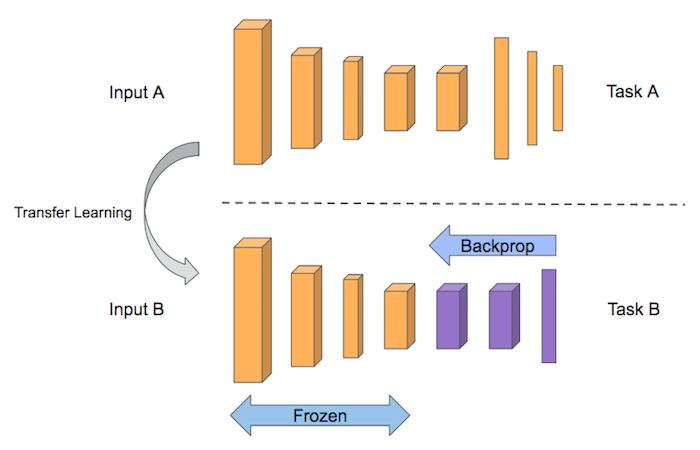
A visual representatuon of transfer learning workflow. Source
Scott: Kind of one shot learning. I mean it's just happening while on the fly. You drop them off and then go.
Susan: You think it's the same delivering presence to say Central Florida, as it is to say, Ecuador or something like that.
Scott: Oh well, or somewhere there's a lot of snow and other stuff, right? But maybe a good move for him would be to disguise himself as the UPS man. Or like the Amazon truck. People would never suspect that.
Susan: I think we've uncovered something exceptionally deep here, Scott.
Scott: What are we gonna do about it?
Susan: I don't know.
Scott: I don't think we should tell anybody.
Susan: No we need to get this technology for ourselves.
Scott: Yeah, let's keep this to ourselves.
Susan: Well this could be our little side research project we keep on investigating. How does Santa do it. This is in the rest of the world when real problems pop up. Once you get that key question you can keep asking yourself. I know it happens in nature this way so there's gotta be a way, and it allows you to keep driving towards the solution.
Scott: Yeah, so you're saying there's a way. A chance.
Susan: I'm gonna say it. And you keep chipping away knowing there is an acceptable solution over here. Santa's done it. Therefore, we can so we keep saying, "How would Santa do it?"
Scott: What would Santa do. WWSD.
Susan: What would Santa do? Would he just throw another GPU on the fire?
Scott: Is he a little more clever than that?
Susan: Either he's just a big data GPU guy or he is really nuanced. Does he hand tweak the model all day?
Scott: Maybe path finding is AI after all. I mean definitely, definitely. Real deep learning stuff happening.
Susan: Well on a serious note, graft theory is getting a little bit of and in-run on deep learning.
Scott: I was serious the whole time.
Susan: We were yeah, of course. I mean talking about path finding though. There's some interesting fun stuff in that world. Especially when you get to graft theory to the huge data world. Well just, what is a tree?
Scott: What is a tree?
Susan: Its a DAG?
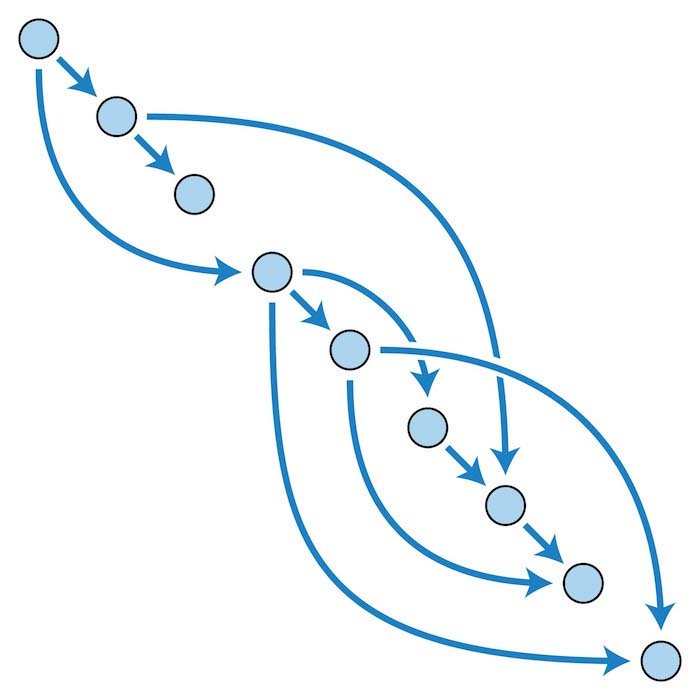
In mathematics and computer science, a directed acyclic graph is a finite directed graph with no directed cycles. Source: Wikipedia
Scott: What is if this is a tree?
Susan: It's a directed acyclic graph, right.
Scott: Directed acyclic. It's not cyclical.
Susan: Exactly and it's graph.
Scott: And directed. Because of the direction.
Susan: So searching a big tree of possibilities is exactly what things like AlphaGo does it really well at. Do you think Santa could be at AlphaGo?
Scott: And if he did what would he do?
Susan: Well I think he could because clearly he's got some edges on graph theory in general to be able to solve the traveling salesman problem, being around the world in such efficient way. He had to have a very efficient tact on this. I mean if Santa was inefficient in his travels around the globe. Then it's clearly an impossible task. But if he's got a super efficient path algorithm. If he's knocked it down somehow. So maybe he's solved PNP. This is big time.
Scott: Whoa, yeah that's big time.
Susan: I don't wanna go into the ridiculous though. I think most people agree that P does not equal NP. And if Santa were to solve that, that'd be like, I mean it's breaking the law.
Scott: He's solved AI, we know that.
Susan: But maybe what he's got is some sort of mixture of classical algorithms and machine learning. To be able to do intelligent grouping of solutions. To get this path finding but still you're using classical mechanisms to tie it all together. I think with that you could get an optimum. Not necessarily the global optimum or a provable optimum. But you could probably could find a much better optimum than just you know.
Scott: Okay, okay. So you're saying you can come to a solution. It might not be the perfect solution. But you did it very quickly.
Susan: Well you did it with, you know just like Monte Carlo.
Scott: Very little effort.
Susan: Monte Carlo tree search and a DAG.
Scott: Santa's probably using Monte Carlo so you could do tree search in a better version.
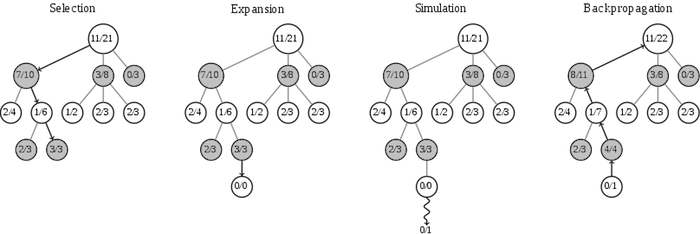
Monte Carlo tree search is a search algorithm used for ceertain kinds of decision processes. Source.
Susan: You have a fixed set of resources. You've got this much time to calculate on. You want to find the best solution within those resources, right. You use a similar set of techniques and you use it for solving this traveling salesman and maybe you've got some good stuff there. You put a little bit of machine learning to do an intelligent selection of possible paths. I don't know, I think you got something possibly there. See since Santa can do it, it allows us to start thinking how does Santa do it. How can you apply these things.
Scott: Yeah, exactly. We know it's possible. We know it's possible.
Susan: Right, you know. There's some really good stuff that we can do there.
Scott: So it's whether he shards or not determines, if he really does it all himself now he's got something special. If he's sharding, and breaking himself off into many pieces to go solve this problem not quite the same. Maybe Santa is an AI.
Scott: Maybe he is.
Susan: How can clone himself so quickly. You know you can be everywhere at once. How is that possible.
Scott: He probably has like a silicon boundary.
Susan: Here it is Scott. Santa is an alien machine intelligence that landed on earth. Gotta be.
Scott: I think that's a 100% true.
Susan: It's gotta be. So all this machine learning is really from an advanced civilization. What we're saying is you know a couple of 100 years from now.
Scott: Why are they doing it though?
Susan: I don't know.
Scott: To keep us happy? To keep us placated.
Susan: If you're a machine intelligence, would you wanna stay on the planet that you're creator started you off on. Why stay next to all that caustic environment, all these bad things? Why not just go out into space. And then you're gonna have lots and lots of replicas going around of your machine intelligence.
Scott: And then if you visit new planets.
Susan: Well you're just going out into the random universe. You go to new stars, you need energy sources, right?
Scott: Takes a long time to do that. But yeah, I guess.
Susan: You just slow yourself down to a few cycles per year or whatever time.
Scott: I guess to you it doesn't seem that fast. Or is that long.
Susan: So he's machine intelligence, he's been floating through the universe for awhile and accidentally crash lands on earth and says why not, I'll build a bunch of machines.
Scott: It's like a vacation a little. Like you're gonna stop over. Little playland, little fun.
Susan: Why not have a little bit of fun. I think that this is a plausible explanation for Santa Claus.
Scott: Yeah we're getting there. Well in the UFO technology there too. You know he can zip around.
Susan: All the energy that Santa's using.
Scott: Yeah he solved fusion.
Susan: He has to. How much energy is in gasoline? Do you think a little sleigh could carry enough energy around to take it around the earth and go to all the homes?
Scott: Yeah it has to be nuclear.
Susan: It has to be, I mean you have to be converting matter to energy. To be able to do what Santa does.
Scott: Yeah we're not talking a couple of orders of magnitude here. It's like millions of orders of magnitude. That's the good stuff right there.
Susan: Pretty serious, serious levels of technology that are being uncovered for Santa.
Scott: So he's an energy genius, materials genius and an AI genius. Probably though not a compute, comp-sci genius. I've heard.
Susan: Really, you don't think so?
Scott: I don't know. Or you just mean P, just isn't NP.
Susan: Oh it clearly is not.
Scott: Well then this is the proof for that.
Susan: I mean come on.
Scott: Hey if Santa could do it, he would have. Right? It's an obvious proof.
Susan: If it's possible I'd say Santa could do it.
Scott: It must not be possible.
Susan: Well he does get around the earth.
Scott: How could the all powerful being...?
Susan: He can't break the laws there. I mean maybe he's got quantum computers up there that are able to solve the traveling salesman problem.
Scott: Of course, I didn't think of that.
Susan: In a non classical way. That could be it.
Scott: I didn't think of that. That's probably it. He's a quantum computing guy. He's talking about cubits all day.
Susan: Another reason why you need a cold environment. He's gotta cool down those, you know...
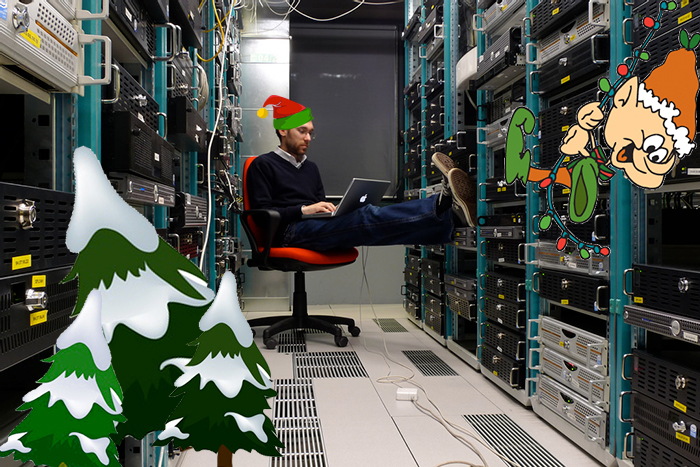
Santa's data centers may be the cause for melting ice caps
Scott: Obviously he cuts down on the liquid helium costs. This is so smart. It's closer to absolute zero up there.
Susan: This guy has some pretty serious technology.
Scott: Wow, this is deep.
Susan: Do you think he's gotten into other fictional territory too, like Easter bunny and stuff.
Scott: Who says they're fictitious first of all?
Susan: You think that's true.
Scott: But yeah, there has to be a convention or something.
Susan: There's gotta be. The tooth fairy's there stealing stuff at night. By the way, what's the going rate for a tooth?
Scott: Personally, a dollar.
Susan: I like a dollar too but my wife is like, it keeps going up each tooth. At this rate we'll be broke.
Scott: Oh we gotta do five, ten.
Susan: At this rate the tooth fairy will be broke.
Scott: Have you ever missed a tooth?
Susan: No, not yet, not yet.
Scott: Oh that one's bad. You have to be like maybe you didn't put it in the right spot? Yeah that one's bad.
Susan: I keep close track of the weekly teeth.
Scott: Maybe your son announces very boldly and very happily that it's out. Not so much with my kids.
Susan: It's tricky.
Scott: If I know the tooth is about to come out, it's like let's do it you know. Let's do it. Let the blood run. Lets go, right? And they're not into that. They're gonna hold on till the bitter end.
Susan: Maybe they're also, they could be like a strategic tooth reserve so when they need money, they pull out the teeth. It's like oh look, I just lost this tooth.
Scott: I really wanna buy this thing. All I gotta do is wait a night. So where is the tooth fairy putting all the teeth.
Susan: That is a very creepy question.
Scott: There's a vault somewhere with everybody's teeth in them. Maybe they do it for the gold. I mean back in the day. This is why we have to supplement it now with a little parental help.
Susan: Especially back in the day they wouldn't fill a kid's tooth.
Scott: I guess it's true. It hurts? Yeah, that's life.
Susan: So you got a cavity in your tooth, it's coming out anyways.
Scott: Let's pull it out. You know your teeth when you're coming out. They consume the calcium from the root of the other tooth. I don't know exactly how much. This is why when a tooth comes out, it's only half a tooth. There's no root left anyhow.
Susan: I did know it dissolved it, I didn't know it went into it.
Scott: I am not sure, I don't know about that one. This is a little speculation but where else would the calcium go, I don't know.
Susan: I mean I can speculate about dentistry all day long.
Scott: So he's hanging out with the tooth fairy and the Easter bunny. The Easter bunny has to be a riot you know.
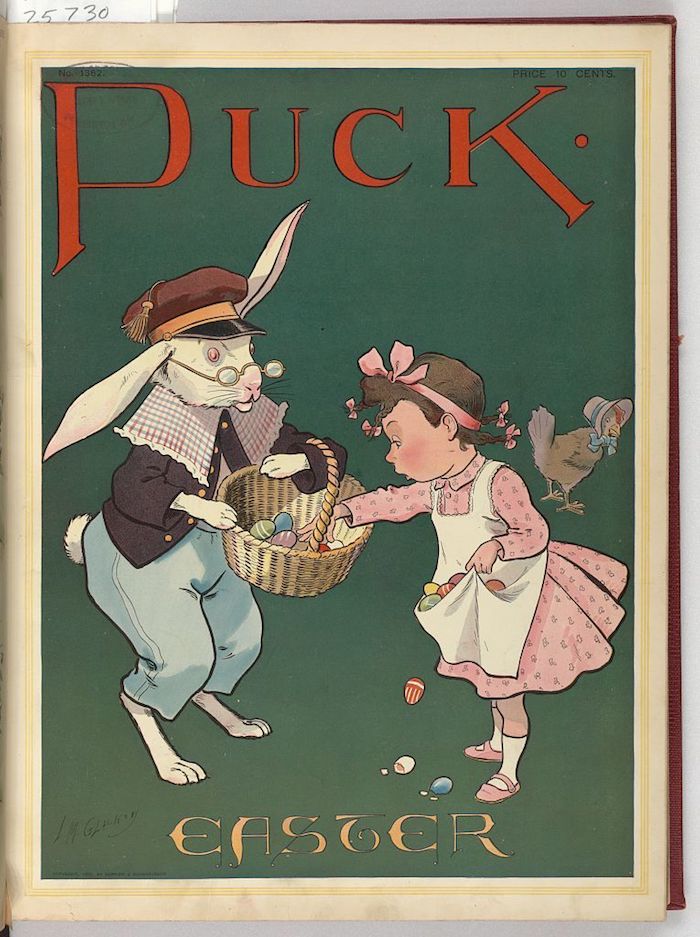
The easter bunny is first mentioned in a German work dating to the 17th century, but does not become popular until the late 19th century. Almost certainly the Pennsylvania Dutch introduced the tradition to America. Source: Library of Congress
Susan: "Let me tell you a story guys. I produce chocolate eggs, from.... I hide them and kids love to find them and eat them!"
Scott: This is real, this happens every year.
Susan: Why is it these entities are so creepy around kids.
Scott: Most of it has to do with kids doesn't it?
Susan: Both the tooth fairy and Santa Claus are sneaking into children's bedrooms in houses. And either taking or putting things.
Scott: I know why it's a machine learning site again. You have to stoke the rebels. You can't be stuck in a rut. The adults are stuck in a rut.
Susan: You go to where the inspiration's at, where your gradient is steepest.
Scott: Many crazy ideas from children.
Susan: The steep gradients there. Maybe that's what it is.
Scott: They're all over the place.
Scott: They're feeding the gradient.
Susan: The alien machine intelligence is really going out and again finding the steepest gradients in society. And trying to explore those steep gradients.
Scott: Pumping energy and motivation into them. Keep them going 'cause it's the only hope.
Susan: It's like you're old and stodgy, you're gradient is like this
Scott: Yours is flat man, you're not going anywhere. You're as good as you're gonna be. I think you're going up actually. This one is the future. Children are the future here. You guys are a lost cause.
Susan: Adults are just boring. From a machine learning standpoint. You could probably predict me and you a whole lot easier than some kid. What we're about to say next, 90% accuracy. Kid's but... I mean I can't predict my own son at all.
Scott: I watched one of the best trigrams ever be produced in life. Live.
Susan: What was it, can you say it on air?
Scott: Uh two kids fighting, not really fighting you know. Make believe here. "I have this guy, and I have this guy. And he has a super power. And this one has a super power, okay. Well guess what this guy's super power is, Gatorade fart tornado." Who puts those words together?
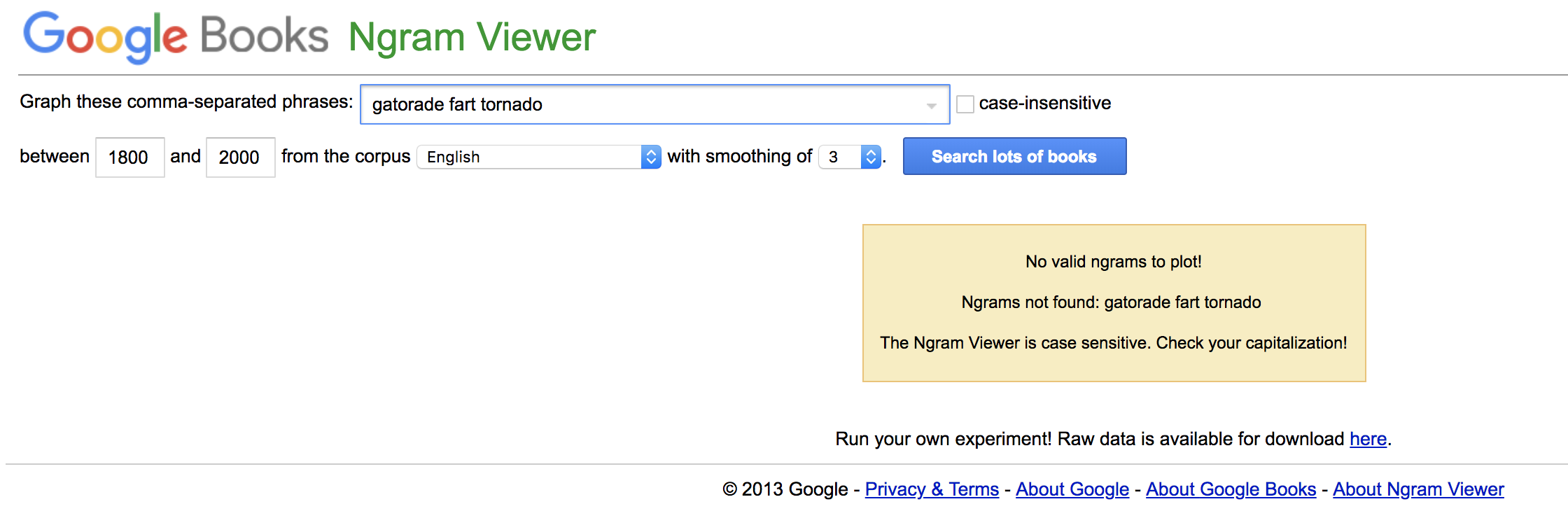
Using the Google Ngram viewer we can see that these three words have never been used in writing. That or only in books that Google has not scanned and run OCR on.
Susan: Put that in your language model.
Scott: Gatorade fart tornado in your language model. Go. You need it. You need the craziness. That's what these guys are up to.
Susan: What's the probability on that trigram? Gatorade fart tornado, I like it. Although just knowing it's a child. The prior probability on the word fart was very high, very high. I mean.
Scott: Gatorade was a recently learned word and is amazing. You know. A tornado is awesome in its own right.
Susan: There is a little bit of believability when you really put that in perspective.
Scott: You need to keep this quiet.
Susan: Now we know.
Scott: Now we need to figure out how we're going to utilize this intelligence.
Susan: That is the million dollar, the billion dollar question.
What's his next move?
Scott: Good point. People think Santa's static. What does he really have up his sleeve?
Susan: What's his long game here. Where is he going with this?
Scott: Children are the future.
Susan: He's got all this data about humanity.
Scott: Tons of data, he's building up the infrastructure.
Susan: He's built the infrastructure.
Scott: That's true. It must be getting better. More people right. It's just a magic number and he just reveals to the world his secrets.
Susan: Is this an in run around Amazon, he wants to take over all e-commerce?
Scott: Yeah good point. Amazon might have to worry.
Susan: Maybe Santazon is coming.
Scott: Santazon. Yeah Santazon.com. And it'll be branded too, you know they'll be happy. They'll be jolly. 24 hour shipping?
Susan: And it's not just in 15 minutes when it's with a happy elf delivering to you.
Scott: And it's not just in December anymore.
Susan: Oh that's the slogan, it's not just December anymore. Three sixty five.
Scott: Well I think we figured it out. It's just some great sleuthing work on our part. Little self congratulations here for sure.
If you have any feedback about this post, or anything else around Deepgram, we'd love to hear from you. Please let us know in our GitHub discussions .
More with these tags:
Share your feedback
Was this article useful or interesting to you?
Thank you!
We appreciate your response.




